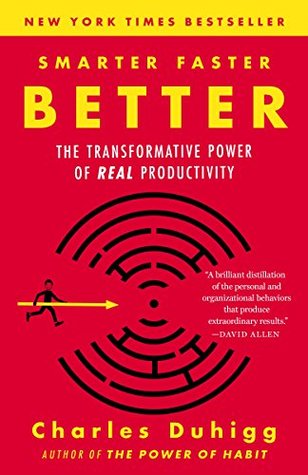More on this book
Community
Kindle Notes & Highlights
Read between
August 30 - December 2, 2022
Motivation is more like a skill, akin to reading or writing, that can be learned and honed. Scientists have found that people can get better at self-motivation if they practice the right way. The trick, researchers say, is realizing that a prerequisite to motivation is believing we have authority over our actions and surroundings. To motivate ourselves, we must feel like we are in control.
This is a useful lesson for anyone hoping to motivate themselves or others, because it suggests an easy method for triggering the will to act: Find a choice, almost any choice, that allows you to exert control.
Motivation is triggered by making choices that demonstrate to ourselves that we are in control.
“The idea is that once recruits have taken control of a few situations, they start to learn how good it feels. “We never tell anyone they’re a natural-born leader. ‘Natural born’ means it’s outside your control,” Krulak said. “Instead, we teach them that leadership is learned, it’s the product of effort. We push recruits to experience that thrill of taking control, of feeling the rush of being in charge. Once we get them addicted to that, they’re hooked.”
We praise people for doing things that are hard. That’s how they learn to believe they can do them.”
If you can link something hard to a choice you care about, it makes the task easier, Quintanilla’s drill instructors had told him. That’s why they asked each other questions starting with “why.” Make a chore into a meaningful decision, and self-motivation will emerge.
Self-motivation, in other words, is a choice we make because it is part of something bigger and more emotionally rewarding than the immediate task that needs doing.
To become genuinely productive, we must take control of our attention; we must build mental models that put us firmly in charge.
Rather, it’s designed to measure a personality trait known as “the need for cognitive closure,” which psychologists define as “the desire for a confident judgment on an issue, any confident judgment, as compared to confusion and ambiguity.”
By the 1980s, this system had evolved into a system of so-called SMART goals that every division and manager were expected to describe each quarter. These objectives had to be specific, measurable, achievable, realistic, and based on a timeline. In other words, they had to be provably within reach and described in a way that suggested a concrete plan.
where crossing things off your to-do list becomes more important than asking yourself if you’re doing the right things,” said Latham.
This is probabilistic thinking. It is the ability to hold multiple, conflicting outcomes in your mind and estimate their relative likelihoods. “We’re not accustomed to thinking about multiple futures,” said Barbara Mellers, another GJP leader.
So the next time a friend misses out on a promotion, ask him why. The next time a deal falls through, call up the other side to find out what you did wrong. The next time you have a bad day or you snap at your spouse, don’t simply tell yourself that things will go better next time. Instead, force yourself to really figure out what happened.
No one can predict tomorrow with absolute confidence. But the mistake some people make is trying to avoid making any predictions because their thirst for certainty is so strong and their fear of doubt too overwhelming.
It seemed as if nature’s creative capacities depended on some kind of periodic disturbance—like a tree fall or an occasional storm—that
she doesn’t know the difference between real love and infatuation. She has to learn that love is about sacrifice.
But systems such as the engineering design process—which forces us to search for information and brainstorm potential solutions, to look for different kinds of insights and test various ideas—help us achieve disfluency by putting the past in a new frame of reference.
One of the best ways to help people cast experiences in a new light is to provide a formal decision-making system—such as a flowchart, a prescribed series of questions, or the engineering design process—that denies our brains the easy options we crave. “Systems teach us how to force ourselves to make questions look unfamiliar,” said Johnson. “It’s a way to see alternatives.”
It’s not enough for your bathroom scale to send daily updates to an app on your phone. If you want to lose weight, force yourself to plot those measurements on graph paper and you’ll be more likely to choose a salad over a hamburger at lunch.
If you read a book filled with new ideas, force yourself to put it down and explain the concepts to someone sitting next to you and you’ll be more likely to apply them in your life.
TO GENERATE MOTIVATION • Make a choice that puts you in control. If you’re replying to emails, write an initial sentence that expresses an opinion or decision. If you need to have a hard conversation, decide where it will occur ahead of time. The specific choice itself matters less in sparking motivation than the assertion of control.
TO MAKE BETTER DECISIONS: • Envision multiple futures. By pushing yourself to imagine various possibilities—some of which might be contradictory—you’re better equipped to make wise choices. • We can hone our Bayesian instincts by seeking out different experiences, perspectives, and other people’s ideas. By finding information and then letting ourselves sit with it, options become clearer.


